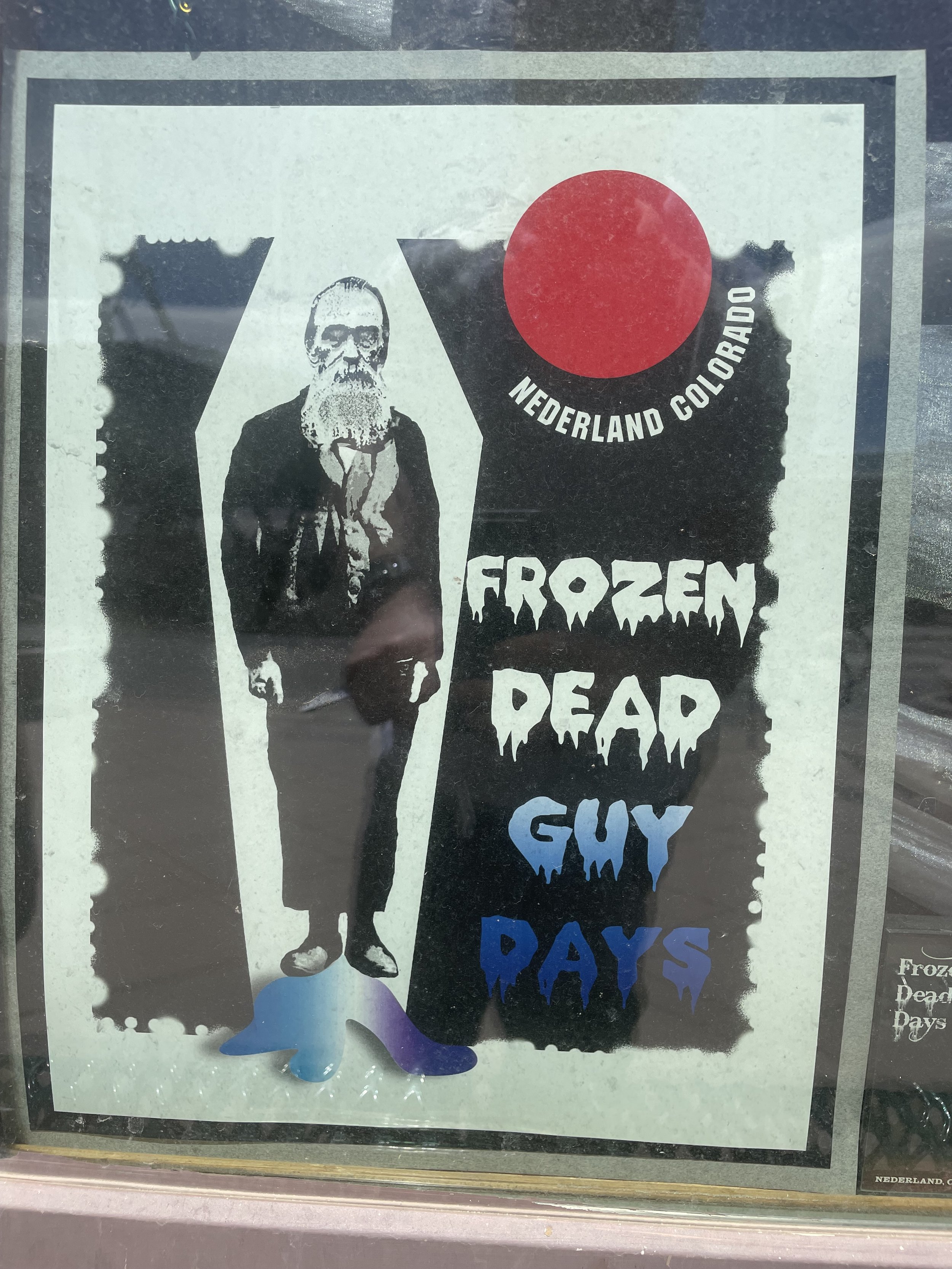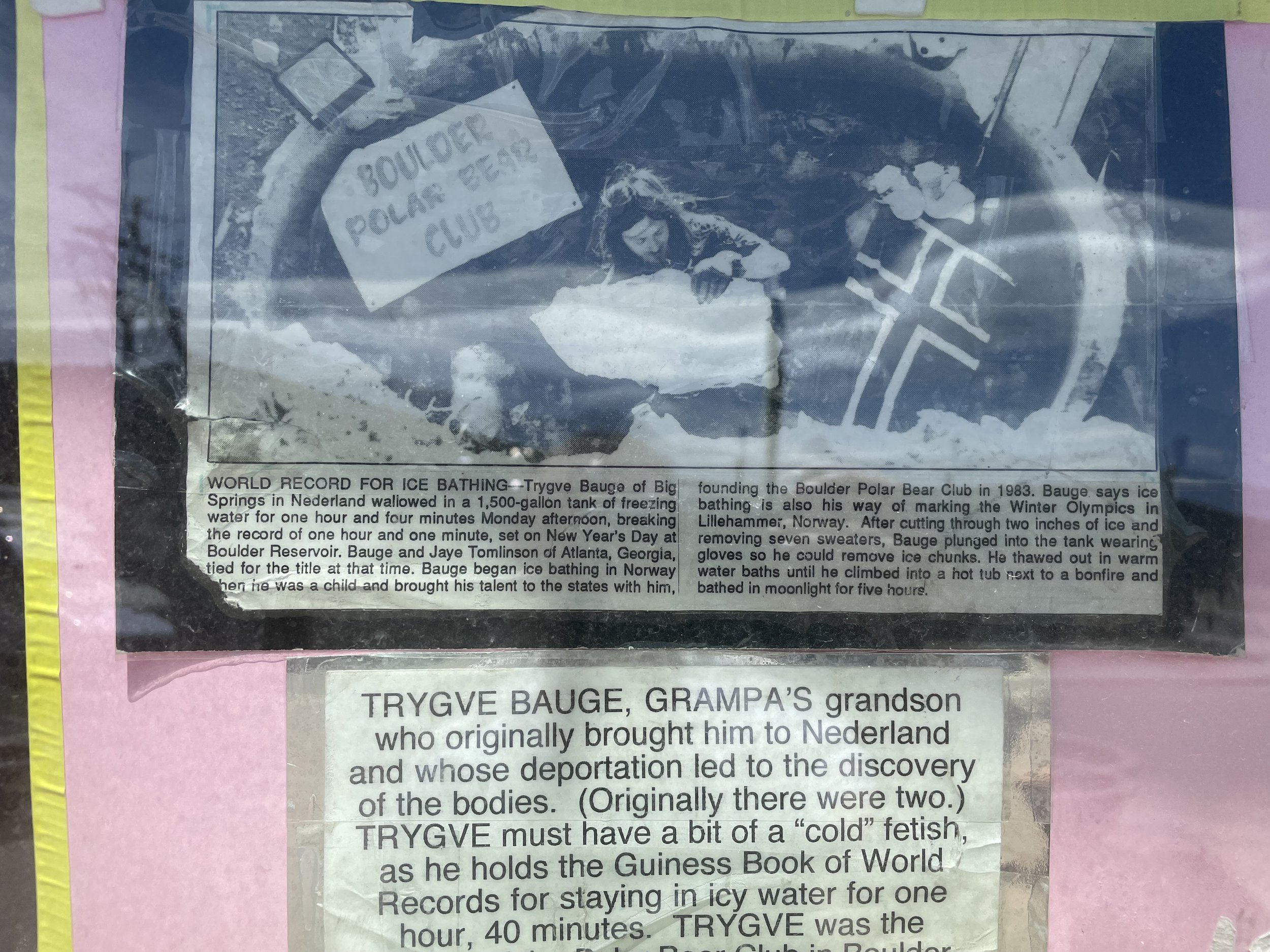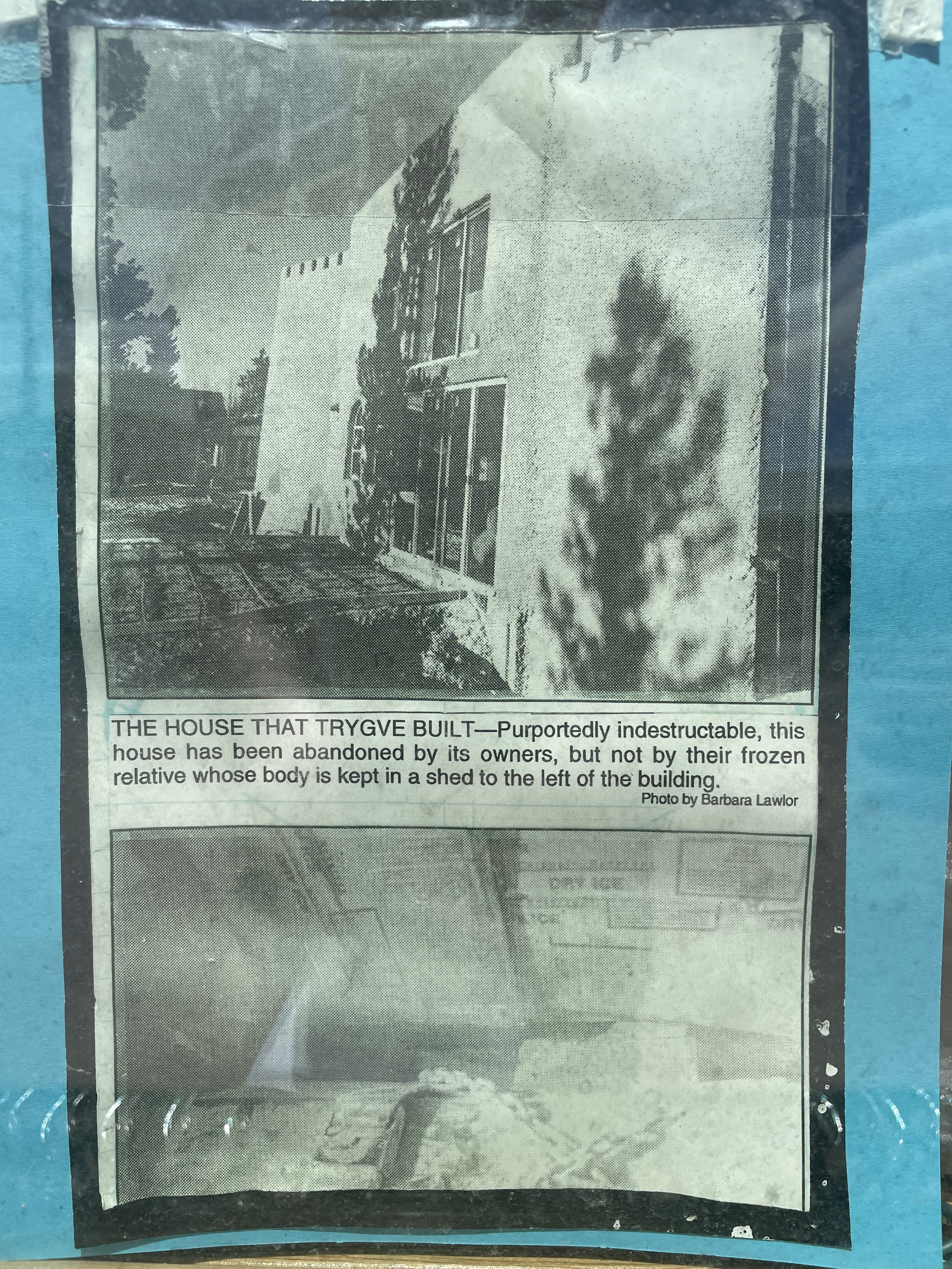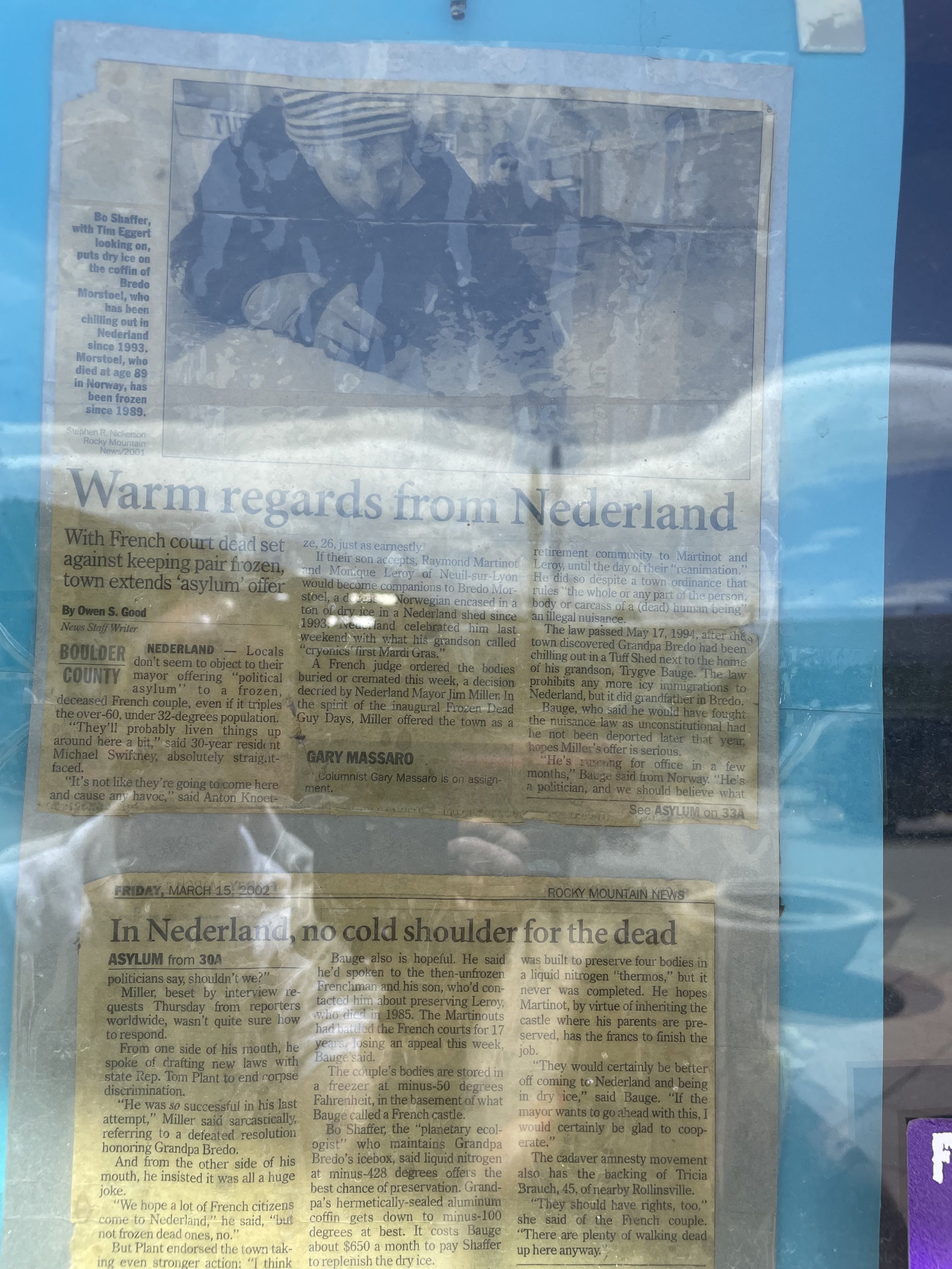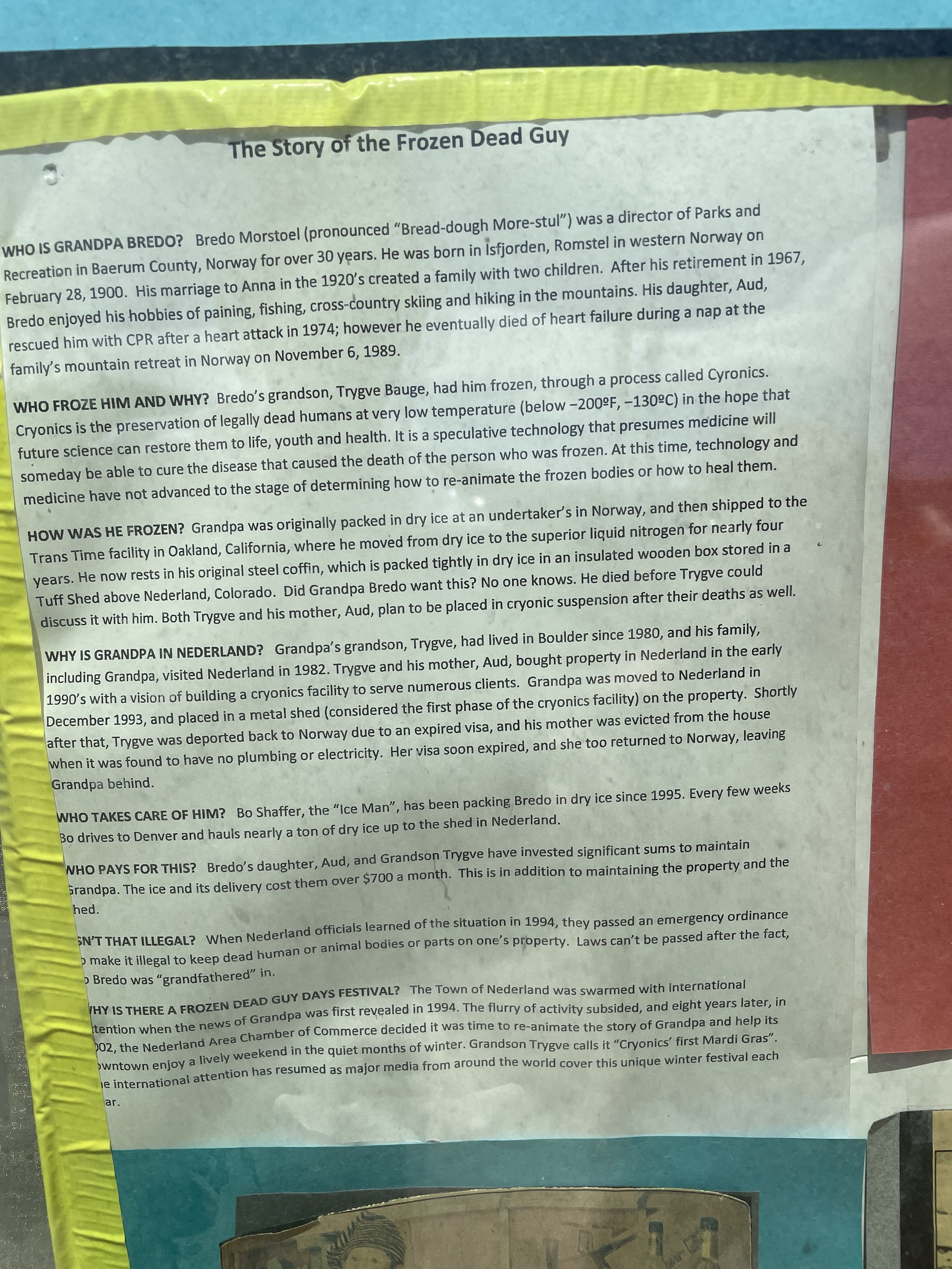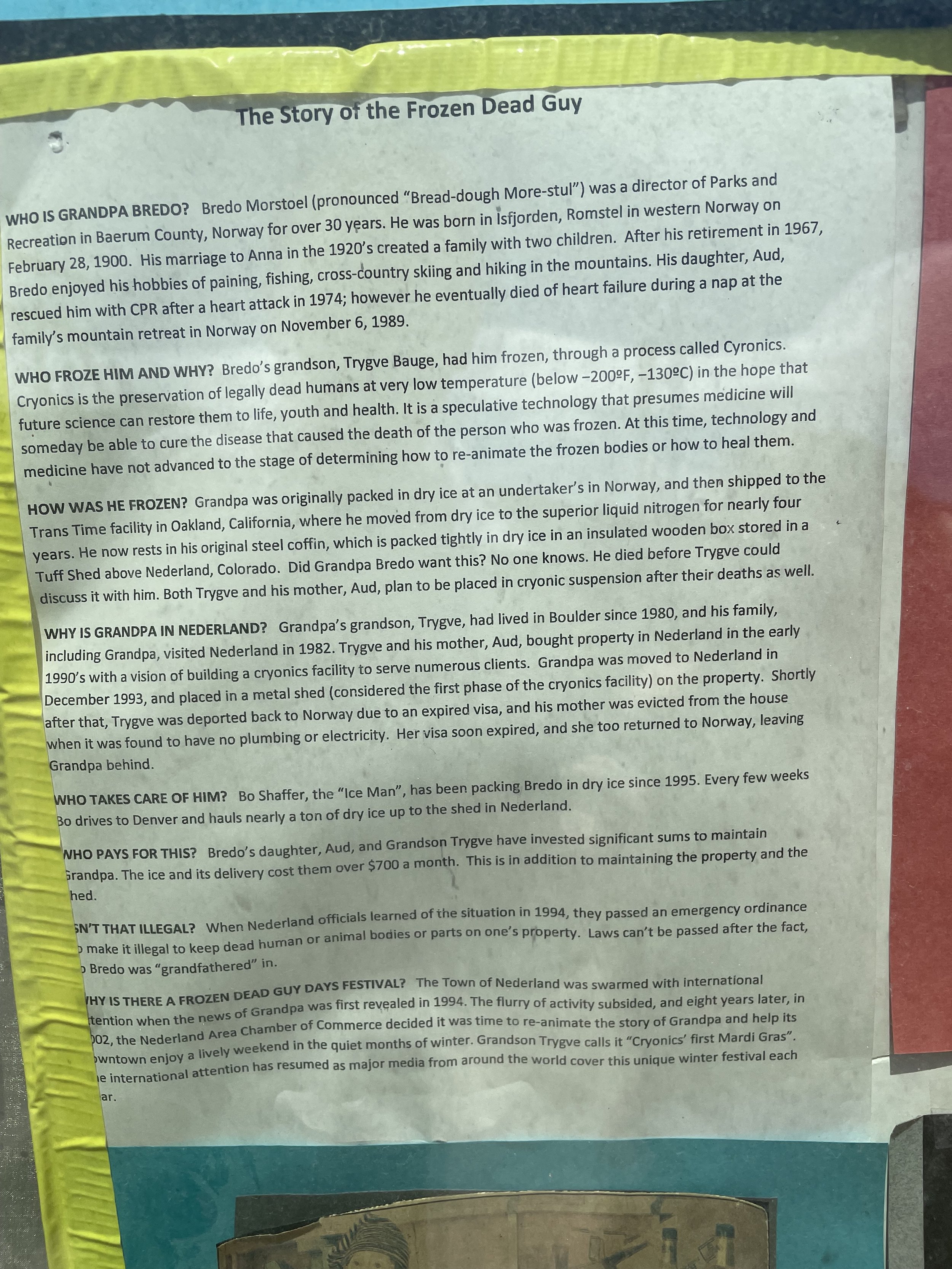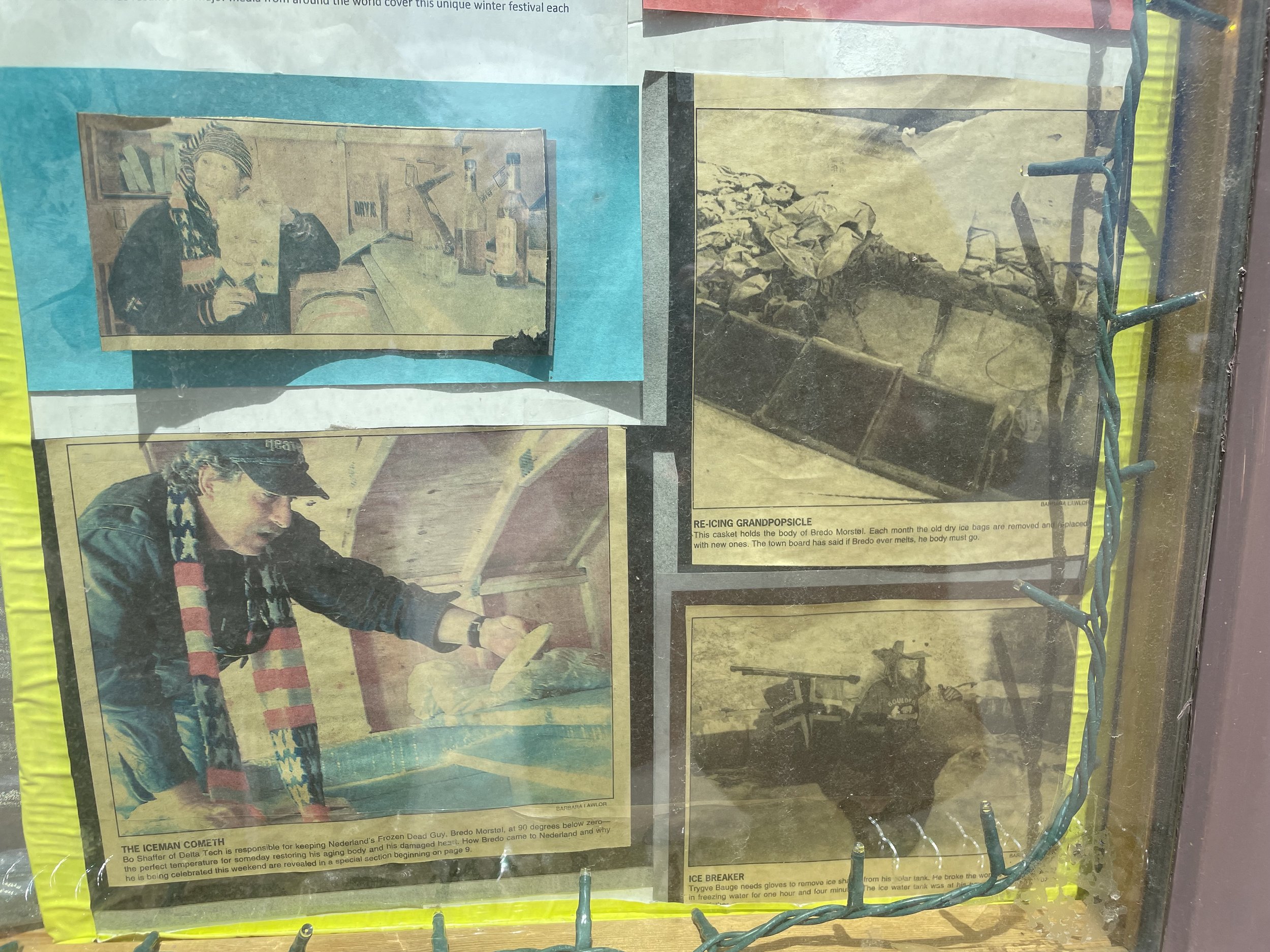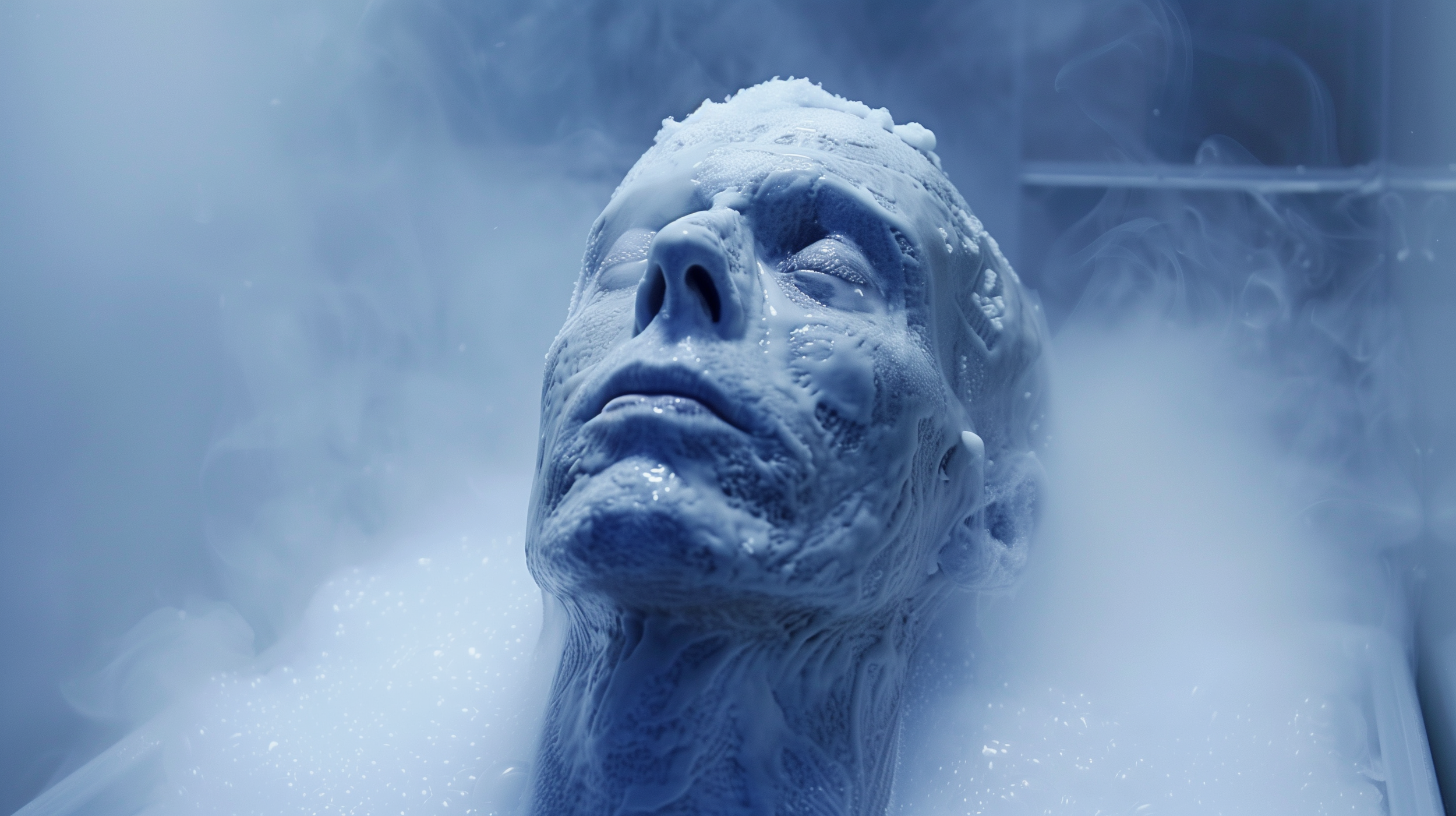The Frozen Dead Guy & the Science of Cryonics
Episode 40
This episode takes listeners to the quaint town of Nederland, Colorado, unveiling its unique history and one of its most chilling tales—literally. The story begins with an exploration of Nederland’s origins, a town once central to the mining industry, now known for its quirky culture and picturesque landscapes.
The focus shifts to Grandpa Bredo Morstoel, a Norwegian whose body was cryopreserved by his grandson, Trygve Bauge, in an unconventional attempt to achieve immortality. The hosts discuss how Bredo, after passing away in 1989, was first cryogenically treated in Norway. His body was then shipped to the United States, where Trygve, an avid supporter of cryonics, kept him frozen in a makeshift shed using dry ice.
The narrative introduces Robert Ettinger, the father of cryonics, detailing his philosophy and the process of cryonic preservation. This leads to an informative segment on how cryopreservation works, including the techniques used to maintain bodies in a state of suspended animation in hopes of future revival.
The episode then examines other high-profile and controversial cases of cryopreservation. It delves into the story of baseball legend Ted Williams and Dora Kent, highlighting the ethical, legal, and scientific challenges that arose from these cases.
As the story of Grandpa Bredo unfolds, the hosts recount the dramatic day his preserved state was discovered by local authorities. The discovery sparked a series of legal debates and media frenzy, which ultimately culminated in the inception of Nederland’s Frozen Dead Guy Days festival. The festival, born from the town's unusual winter resident, celebrates its unique history with icy events that draw visitors from around the globe.
Script
This is the My Dark Path podcast.
What it is about the human condition that makes us believe that the odd, eerie or abnormal are only a relic of the past? Perhaps it’s just a generational hubris that makes us believe we're more enlightened than the previous. Mark Twain, ever the humorist, observed: “When I was a fourteen, my father was so ignorant I could hardly stand to have the old man around. Then, I turned twenty-one, I was astonished at how much he had learned in seven years." As we age, I think we realize that humans are very much the same across the years, despite very different circumstances.
Strange uses of the bodies of the dead certainly fall into this category. Some we’re more familiar with, such as the embalming practices of the ancient Egyptians.
In one of our early episodes of My Dark Path, we covered the story of Elmer McCurdy who became much more famous in death than he ever had in life. He was a rather unsuccessful bank and train robber. In his last ill-fated heist, he was shot and killed in a gunfight with three sheriffs. His corpse was brought to an undertaker in Oklahoma who used new embalming technique. But when no one paid for the morticians work, Elmer started his illustrious post-death career in show business. First, the embalmer demonstrated his advanced technique by putting Elmer on display. Then through a series of increasingly bizarre transactions, Elmer’s corpse was purchased by different people in show business, appearing in movies and amusement parks. All the while, his exploiters gradually forgot that this prop, was, in fact, a corpse. Forgot, that is, until his arm broke off as he was being moved around the set of the TV show, Six Million Dollar Man. To the horror of the crew, they realized the mannequin was actually a human corpse.
You can find the full, amazing and tragic story of Elmer McCurdy in season 1 of My Dark Path.,
With Elmer’s story in mind, an odd event in Colorado caught my attention. The town of Nederland celebrates ‘Frozen Dead Guy’ Days every year. Without any additional insights, I knew I had to make the trip there and investigate. At the very least, if there were no actual frozen dead guy, I’d have a good story about an event that over promised and under delivered. But as I learned, this festival was inspired from an event on the not-so-historic date of November 6th, 1989. This journey opened my eyes to the world of cryonics and how the idea living after death no longer only exists in the realm of science fiction, but is, in fact, on the precipice of scientific reality.
Hi, I’m MF Thomas, and this is the, My Dark Path, podcast.
In every episode, we explore the fringes of history, science, and the paranormal. So, if you geek out over these subjects, you’re among friends here at My Dark Path. Find us on Instagram, visit mydarkpath.com and see our videos on YouTube. But no matter how you choose to connect with us, I’m so grateful for your support.
Also, if you want more My Dark Path, subscribe on Patreon! I’m releasing a new, subscriber-only episode every month. Plus, subscribers get free My Dark Path swag like t-shirts, books and more. I appreciate our subscribers so much as they help the show grow!
If you stay until the end of the episode, you’ll hear a special promotion for the Ghostly podcast. It’s one of our favorites here at My Dark Path.
Let’s begin with Episode 40, The Frozen Dead Guy.
PART 1
The history of Nederland Colorado itself significantly predates this unusual festival. The town was formally established in 1874, but started out approximately 25 years earlier as a trading center between the Ute Native American Tribe and European settlers who explored the west. The Utes were among the oldest residents of Colorado.
Like other indigenous populations, the effort to maintain the lands against the westward expansion became a losing battle. They were uprooted from their homeland and pushed onto barren lands that were of little to no use. Several treaties between the Utes and the US Government failed in 1863 and 1868. But finally, on September 13th, 1873, following renewed negotiations, leaders from various bands of the tribe, along with representative from the US government, Felix R. Brunot, signed an agreement which later became knowing as the Brunot Treaty. It was ratified in 1874 and Nederland was subsequently incorporated on November 15th, 1885. Nowadays you may know Nederland as the gateway to several national parks and wilderness preserves. But, Nederland wasn’t the original name of the settlement. First it was called Dayton, then later, Brown’s Crossing. After the first post office was established in 1871, it became Middle Boulder after a creek that cut through the middle of the town.
The current name came about when, in 1873, when the Nederland mining company purchased the Caribou Mine, located about 6 miles northwest of Middle Boulder. The Caribou mine is at a very high elevation - approximately 10,000 feet above sea level.
At this altitude, the weather – freezing cold weather, deep snow, and brutal winds – required that the ore be processed at a lower altitude in Middle Boulder. Interestingly, the Dutch word Nederlands translates to ‘low land’ in English. With all the Dutch mine workers referring to Middle Boulder as Nederland, that became its official name when the town was incorporated. Today, Caribou is a ghost town while Nederland has become a popular pit stop for those making their way to the nearby outdoor recreational sites. But it’s role as a gateway to national parks is juxtaposed to an annual 3-day non-stop party, complete with non-stop live music and themed events, including obstacle courses, coffin races, a hearse parade, the ‘Frozen Dead Guy’ look-alike contest, a polar plunge, human foosball, a frozen sculpture contest and a gala called, ummmm, ‘Grandpa’s Blue Ball’. If you happen to find yourself at this festival, you can also take a tour of Tuff Shed turned Mausoleum which is where the festival, and our story, begins. More on the Tuff Shed later.
The man at the epicenter of this entire festival is, Bredo Morstoel, often affectionately referred to as ‘Grandpa Bredo’. His role in our story starts on November 6th 1989. While at his family’s mountain retreat in Norway, he died of heart failure.
Grandpa Bredo was born on February 28th, 1900 in Isfjorden, Romstel, Norway and settled in Baerum, a little west of Oslo. In 1928 he married a woman named Anna and by 1930, their daughter, Aud, was born. Bredo spent his career as the head of Baerum’s department of parks and recreations, from which he retired in 1967.
After his wife passed away in 1978, he stayed in Baerum where he enjoyed being outdoors, skiing, fishing, and painting. In 1975, Bredo nearly died from a heart attack while on a long ski trip. His daughter Aud revived him with chest compressions.
But throughout the 1980s, Bredo continued to suffer several mild heart attacks. He attempted to become a candidate for a heart transplant, but was turned away by his doctors, so he settled for a quiet, sedentary life until his death in November 1989. Like Elmer McCurdy, Bredo gained all of his notoriety after his death; but unlike Elmer, Grandpa Bredo hadn’t been an unsuccessful criminal. When Trygve Bauge, Bredo’s grandson, 31 at the time, heard the news of his death, he immediately planned to preserve his beloved Grandpa.
Putting your deceased grandpa on ice, is, well, an unusual thought. However, Bauge was an unusual person. The more we’ve learned of him, the more his instinct to freeze Grandpa Bredo is, consistent with who he is.
Years later, he revealed that he believed he had received a message from his grandpa asking him to take care of his remains. He said that the pillows were arranged on his grandad’s bed in such a way that they formed a letter T, the first letter in his name. Whether this was a communication from the afterlife or not, Bauge was committed to preserving his grandfather’s body in the hope that, perhaps, one day, Grandpa Bredo would live again.
At the time, Bauge had been living near Boulder Colorado for nearly a decade on a temporary visa. During his time there he became known amongst the locals as a sweet, albeit eccentric young man who could be recognized with his distinctive long beard.
Bauge was deeply concerned about several topics, including surviving a nuclear war, ice bathing, and cryonics. That’s a unique combination, but his esoteric interests were not totally out of sync with others in Boulder. Bauge’s interests even found their way into the community, and he is credited with inspiring Boulder’s annual New Year’s Polar Bear Plunge. Today, hundreds of people take part in the plunge every year where people jump into freezing water. In fact, he once held the world record for ice bathing. So, when he learned of his grandfather’s death, he had his grandpa’s body moved to a cryogenic facility run by a company called Trans Time in San Leandro, California. Once at Trans Time, grandpa Bredo’s body was cryonically preserved and then maintained in that state for 3 years. Bauge never formally discussed his specific reasons for cryonically preserving his grandfather. Still, the reason why this technology has been developed is one of pure faith – faith that an essentially frozen, preserved body can be reanimated in a future where death and disease are eliminated and the body can restored to normal human life. It’s a fascinating, and fundamentally optimistic view of the future. But it does now raise the topic about the history of cryonics.
PART 2
The father of cryonics is considered to be Robert Ettinger. Today, the word Cryonics means the practice of preserving life by pausing the dying process using subfreezing temperatures with the intent of restoring good health with medical technology in the future. He was born in 1918 in New Jersey, to Russian Jewish parents. Raised as a Jew, he became an atheist later in life. It’s not entirely clear how his rejection of religion and faith impacted his interest in cryonics. Perhaps it was driver of his passion for finding the cure to death. But ultimately, he published the paper, ‘The Prospect of Immortality’ in 1962.
Ettinger’s interest in science fiction and belief in the constant advancements in technology and medicine fueled his idea that aging and dying might one day become voluntary. However, as the years ticked by, human beings were aging and continuing to suffer from incurable illnesses. Reluctantly, Ettinger had to accept that the secret to eternal life might not occur in his lifetime. So, he decided to find his own path to immortality.
He wondered if there was a process in which his body could be frozen in a way where he could be preserved until the time came where science was sophisticated enough to bring him back to life, effectively circumventing death.
Within a few years of the publication of the Prospect of Immortality, the theory was put into action for the first time with a Professor of Psychology at the University of California. On January 12th, 1967, just 2 hours after he succumbed to his battle with cancer, James Bedford became the first person to be Cryopreserved.
Shortly after Bedford died, his body was packed in dry ice and stored inside a heavily insulated container. He was later placed in liquid nitrogen to further cool his body and a cryoprotectant was injected into his body. And then over the course of the next 15 years, he was moved to a series of different facilities in Arizona and California, finally ending up at the Alcor Life Extension Foundation located in Scottsdale where Bedford remains to this day.
Reportedly, the last time Bedford’s body was visually examined, there were no outward signs of deterioration. Unfortunately, that may not necessarily mean that Bedford is ready to reanimated successfully in the future. Since the time of his preservation, advances in the field of cryonics indicate that there is little chance he could be resuscitated successfully.
First, the Cryoprotectant compound he was injected with has been found to be not as effective as originally assumed, meaning his brain is likely damaged beyond repair. Second, the process of freezing a body without forming ice crystals, was not possible at the time of his death. The technique of rapidly cooling a liquid while preventing the formation of ice crystals is known as vitrification. This makes it likely that ice crystals likely formed in his cells and damaging tissues throughout his body.
Nevertheless, the day of the 12th January 1967 is annually celebrated by those interested in the field as it memorializes the day of the first cryonically preservation procedure.
Today there's an estimated 500 people cryopreserved, including 388 in the United States. And, if Cryopreservation of the entire body is too expensive, some opt for neurocryopreservation where only the person’s head is preserved. Meanwhile, Russia has 80, and a handful of frozen bodies can be found in China and Australia, which are the other major players in the business of cryonics.
Alcor is home to other famous people who are cryogenically preserved. One of which is Ted Williams, arguably one of the greatest hitters in baseball history. While Williams’ body may be at peace, how it arrived at Alcor has been mired in controversy following his 2002 death. Rumor has it that Williams’ head was removed from his body, shaved then had numerous holes drilled into it, and then placed inside a liquid-nitrogen filled receptacle that might resemble your average kitchen stock pot. The rest of his decapitated body is stored in liquid nitrogen inside steel cylinder number 6.
Sports Illustrated conducted an in-depth investigation in the year following Williams’ death, casting doubt whether he even wanted to be placed into cryopreservation in the first place. The procedure was given the go-ahead by 2 of Williams’ children, John Henry and Claudia. His oldest daughter, Bobby-Jo, battled against having it done, insisting that their father’s will stated he was to be cremated and his ashes be scattered in the ocean off the Florida coast. However John Henry and Claudia fought back. They produced a note purportedly written and signed by them along with Williams some 3 years after he signed his will that the 3 of them agreed to be placed into ‘biostasis’ after they all died. That note, signed right before Williams underwent a surgical procedure, was written on a napkin. Their wishes, it stated, were to someday be together in the future if there was a chance.
It's reasonable to think that a handwritten note on a napkin might not be sufficient to authorize a cryonic preservation procedure, but it still went ahead. But the circumstances get even worse. Williams, it is suggested, was in a disoriented state during a tape-recorded conversation he had with company representatives when they met him in person.
Incidentally, legendary broadcaster Larry King who passed away at the age of 87 on January 21, 2021, famously stated in 2016 that when he died, he wanted the “full Ted Williams treatment”. King was serious about being cryogenically preserved in the hope of waking up 100 years from the time of his death.
So, perhaps you’re tempted by the process of cryonics and want to know how to go about it.
In the United States there are 2 major companies providing the service: Alcor, located in Scottsdale, Arizona, and the Cryonics Institute in Clinton township, Michigan. Once you pick your cryonic service provider and pay your fees, you’ll start your membership by wearing a bracelet or a necklace that should be worn at all times. But, unlike your standard medical card indicating that you have a condition that may require unique medical care, your bracelet or card would say something like -
WHOLE BODY DONOR
IF DEAD, COOL WITH ICE
ESPECIALLY HEAD
DO NOT EMBALM OR AUTOPSY
SEE REVERSE - REWARD
UNIFORM ANATOMICAL GIFT ACT
WHOLE BODY DONOR TO CRYONICS INSTITUTE -
But, because medical staff can miss these cards or jewelry, some members have the emergency instructions actually tattooed directly on their chest.
The next stage in your preservation is very straightforward. Your journey to the future via cryonics is to, bluntly, die. Cryonicists believe death to be a process rather than an event, starting when a person’s heart stops and ends at a point of brain death, or essentially a point where the brain has deteriorated so extensively that no future technology could ever restore it and its contents retrieved. So, being cryopreserved might be considered nothing more than a ‘protracted medical emergency’.
But here’s an interested twist, if a cryonics company cryopresrves somebody who has not yet been pronounced dead, then under the law, they are committing murder, even if that person is terminally ill with no hopes of survival and wishes to be cryopreserved.
Now this isn’t just a theoretical discussion. Alcor’s 8th cryonicist, Dora Kent. She wasn’t just an anonymous individual, but the mother of life extension activist and Life Extension Foundation co-founder, and former Alcor board member Saul Kent. In December 1987, while already struggling with Alzheimer’s, the 83-year-old Dora came down with pneumonia.
Her son had her transported to an Alcor facility where she died on December 11th. Immediately following her death, her head was separated from her body and stored in liquid nitrogen. But here’s the problem - when she died, there was no doctor present.
Dora’s body was later sent to the county coroner and autopsied where it was determined her cause of death was pneumonia. However, the coroner later stated he found evidence that she may have been alive when the cryopreservation process began. In particular the coroner could not determine if the cyropreservative drugs had been administered before or after Dora’s death. As such, he requested Alcor turn over the bodies and records of all 8 of their patients, including Dora’s head. The coroner called a press conference and made accusations that maybe Dora wasn’t dead after all when the cryonic procedure started.
Soon after, a SWAT team conducted a raid on the facility, hoping to seize the frozen head of Dora, claiming it was necessary to test it to determine the cause of the death. The facility, somehow tipped off to the raid, successfully moved her head to another facility. Another raid, conducted just days after the first, seized most of the equipment in the lab. While legal battles continued, Alcor successfully sued the county. In addition, a restraining order was granted against the county coroner to protect Alcor patients (including Dora’s head) from any future attempts at seizure. The legal battle over Dora reflects the tension in cryopreservation…balancing the urgency to start preservation as quickly as possible after death with the need to ensure that the patient has, in fact, died.
Fortunately, your cyronic preservation procedure won’t be as controversial as Dora’s. So, once you’re officially and legally dead, the preservation procedure starts. Even before the body, or patient, arrives at a cryogenics facility, blood circulation and breathing are restored temporarily, to protect the brain, and so protective medications can be given. The patient is then cooled in an ice water bath, and blood is replaced with a solution that is designed to preserve organs.
After the cooling, the patient is transported to the operating room at the cryogenic facility. Immediately after the patient’s arrival, additional cryoprotectant drugs are perfused via the patient’s blood, to limit or outright prevent freezing. Then, once prepared, the patient’s temperature is slowly cooled to -196’ C, or -384’ F over a period of 5 to 7 days. Once prepared, the patient is transferred to a large stainless steel container, with a temperature maintained by liquid nitrogen. And there, the wait, the long wait begins for a time when technology might enable the patient to be reawakened in the future.
Of course, it’s easy to scoff at this, the urgency of the preparations, the precision of process. Yet, we’ve marveled at the sci-fi movies like the Alien series, where astronauts sleep and are reawakened after some form of cryosleep. Perhaps, just perhaps, the aspirations implicit in cryo preservation aren’t so extreme afterall.
PART 3:
So, let’s now travel back to San Leandro, California, where Grandpa Bredo was cryopreserved at the Trans Time. Whether it was the cost of maintaining his grandpa or just a desire to keep him close by, Bauge was busy making the arrangements to establish his own cryonics facility back in Nederland. Bauge had been thinking about this for some time, even going so far as exploring the option of establishing it on a ship in order to keep his operation far from the reaches of government oversight. But this plan was far beyond his resources, so he started on a much smaller scale in Nederland. In 1992, he submitted a proposal to the town’s planning commission about building and establishing his cryonics facility, but the proposal was denied. He began construction anyway. Using the money he received from selling Grandpa Bredo’s summer cabin in Norway, he purchased land in Nederland and started to build. His design included all the necessary cryonics infrastructure, including several subterranean storage pods, but it would also serve as a home for himself and his mother, Aud.
Bauge’s obessions with survival extended through his design. He required the facility be able to withstand anything mother nature could throw at it - earthquakes, mudslides, and fire. The main structure would be made from steel-reinforced concrete and outfitted with fireproof insulation applied using high pressure hoses. There would be nothing combustible used in construction except for the building’s windows, but this would be a feature Bauge was unwilling to leave out. It would be indestructible. The building, looking very much like a castle, still exists today. By the way, you can check out our collection of photos, including the Castle House, on mydarkpath.com.
Bauge then flew Grandpa Bredo from California to Stapleton Airport in Denver then drove him to his new home. However, the advanced cryogenics center he’d hoped to build, wasn’t to be. Instead, Grandpa Bredo’s cryopreserved body was kept in a small garden shed, cooled by dry ice. The unsophisticated facility didn’t prevent Bauge from soliciting additional cryonic patients and soon he signed up his first paying client, Al Campbell, a Chicago man who succumbed to his battle with liver failure in 1994.
Campbell had not made arrangements in advance for cryopreservation and facilities at the time usually didn’t accept ‘walk-ins’, so he was referred to Bauge’s facility. Campbell’s family signed a 6-month contract while they searched for a permanent arrangement at an established cryonics facility.
Fueled by his first business success, Bauge planned to improve the capabilities of his facility by purchasing a Dewar container. This is a huge stainless steel cylinder, reminiscent of something you’d see in a Walter White’s illegal meth lab or a high-end brewery but is the method that advanced cryonics facilities use to preserve their patients for decades.
But Bauge’s rudimentary cryo facility quickly ran into a major legal issue, just months after Campbell arrived. It turns out that Bauge had overstayed his visa by 14 years. He was deported back to Norway in May 1994, leaving responsibility for taking care of Campbell and Grandpa Bredo to his mother, Aud.
Heartbroken and distraught, Aud spoke to the local newspaper, the Nederland Mountain-Ear a few days after her son was deported. Whether her statement was intentional or just a slip of the tongue, she shared that she had no idea what was going to happen to their bodies. That’s a scoop on the magnitude that few small-town newspaper writers will ever get.
Shortly after the interview, the rumors of frozen dead bodies rippled through Nederland and the surrounding area. And soon local police learned of the shed and its unusual contents. The town ordered an immediate cease and desist order, requiring Aud to move the bodies immediately or allow city officials to take possession of them. Outraged, she appeared before the mayor and city council. The city passed an ordinance that effectively outlawing the storage of dead bodies on private property.
Aud, though, received support from members of the local community, but the property was ruled to be in violation of a number of zoning codes, including a requirement that the property have running water and electricity. The castle house may have been impervious to fire and flood, but lacked the basic utilities. Aug was ordered to remove her father’s frozen body by March 6, 1995 or face a fine and jail time. But the local news quickly became an international story. Reporters and TV crews from around the world quickly discovered the tiny town in the mountains of Colorado and the story of the frozen dead guy. Al Campbell was claimed by his family, shipped back to Chicago and cremated. But the global media frenzy portrayed Grandpa Bredo’s situation in a sympathetic light, having an effect on the town’s leaders. Although their ordinance outlawed the keeping of bodies within the city, they made an exception for Grandpa Bredo. Bauge, back in Norway, was busy trying to upgrade his grandpa’s situation. He secured the support of a local environmental company to maintain the facility. And in that same year, a local radio station and Tuffshed built an upgrade shed to house Grandpa Bredo. And with the legal situation resolved and the maintenance of Grandpa Bredo’s body in better hands, the story of the Frozen Dead Guy in Nederland went quiet for a time.
Bo Shaffer, the CEO of the environmental company, kept bringing ice until 2012, earning him the nickname the ice man. From his home 45 miles outside of Nederland, Bo would bring approximately 1800 pounds of dry ice once a month to the hilltop facility. By this time, Grandpa Bredo’s body was housed in a metal sarcophagus which was encased inside a freezer sized box Bauge made out of plywood and Styrofoam. During Bo’s visits, he would record the temperature inside the freezer box, which ranged from a high of -60℉ to a low of -100℉.
Bo’s tenure as the caretaker ended in 2012 as a result of an undisclosed conflict with Bauge.
So how did Nederland go from attempting to evict Grandpa Bredo to embracing an annual festival that seems like a mountain version of burning man? Well, Nederland had held an annual spring festival and every year the Chamber of Commerce was tasked with coming up with a theme. The spring festival didn’t exactly have enough appeal to entice locals from the closest big city of Boulder to make the half hour drive across the still snow blanketed highway 119. They needed to get creative…what was it about Nederland that set the town apart? Something unique, that no place in Colorado had that could draw hordes of visitors.
At a chamber of commerce meeting, one of the members brought up a small-town event he’d recently heard of. The western Colorado city of Fruita, about 4 hours away from Nederland outside of Grand Junction, was gearing up for their 4th annual “Mike the Headless Chicken Day” - a quirky yet uproarious festival that celebrated Mike the Chicken who somehow managed to survive for 18 months after being decapitated. The morbid novelty of it all made the festival one of the area’s most popular events. And so, Nederland clearly had an even more morbid tale than the headless chicken of Fruita in the form of the Frozen Dead Guy of Grandpa Bredo.
2002 marked the inaugural year for The Frozen Dead Guy Festival, which kicked off the first weekend of that March. It is perhaps not surprising that the event was an instant hit, bringing in upwards of $50,000 for the local merchants. Festival goers ate, drank, shopped, indulged and partook in all the cryonics-themed festivities. It had elements reminiscent of Mardi Gras, Oktoberfest, Burning Man, the Mummer’s Parade, and perhaps even Headless Chicken Day, all rolled into one boisterous festival that turned what was once considered the town’s worst liability into their best and brightest asset.
Bo still attends the Frozen Dead Guy Festival each year to celebrate the now 122-year old Bredo Morstoel. And in case you are wondering, no, Bo Shaffer never opened up the sarcophagus to take a peek at what Grandpa Bredo looked like after being kept on ice for more than 2 decades, but he is honored to have cared for Nederland’s most famous resident.
The job of caring for Grandpa Bredo, along with the keys to the shed were handed over in 2012 to Brad Wickham who saw the opportunity as his chance to work through his struggles with PTSD, which had sent him into a downward spiral of self-medication with drugs and alcohol. For Wickham, taking care of Grandpa Bredo was indeed a lifesaving, healing experience for him. He retired from the role just 2 weeks before what would have been the 20th annual Frozen Dead Guy Days Festival if it had not been canceled in 2020 because of COVID-19.
And today, at the time of this recording, Grandpa Bredo who is now being cared for by Amanda MacDonald, the Frozen Dead Guy Festival co-owner and event coordinator.
So, how does Bauge feel about the Frozen Dead Guys Festival? Initially, both he and his mother seemed all for it. In fact, in 2005, Aud was asked to be the Grand Marshall of the festival’s parade. After lobbying two of Colorado’s congress members and Norway’s King and Queen, Aud was issued a 3 month visa to travel to the United States for the event. But once she got to Nederland and saw how much money was being made off her father without sharing any of the profits with Grandpa Bredo’s family, she became angry. There was at least one confrontation between Aud and one of Nederland’s local merchants over money Aud claimed she was owed for selling Grandpa Bredo t-shirts, after which Aud was arrested and charged with harassment. From Norway, Bauge attempted to shut the entire festival down, but the only authority he really had was to ban any further tours of Grandpa Bredo’s shed. But, it was clear for all to see that what had started as one frozen dead guy in a shed, had turned into something much, much greater.
The icy relations between its organizers, the town of Nederland and Bauge eventually thawed and visitors could again get a tour of Grandpa Bredo’s shed. Bauge no longer opposes the commercialization of Grandpa Bredo, perhaps because he is paid a 1/3 of all tour profits and because he holds at least 51 trademarks including ‘Frozen Grandpa’.
Grandpa Bredo and all the other people we have discussed today are by no means the only people determined to survive the greatest hurdle to immortality: death itself. I certainly don’t want to judge anyone’s attempts to outlive this mortal existence. If anything, I think the pursuit of cryonic preservation is a very optimistic perspective about the future. Why would you want to preserve yourself to be resuscitated if you didn’t think the future would be worth living in? No matter what skepticism we may have about the technology, I love the optimism that is embedded in its pursuit. But not matter your perspective, if you want to see how one frozen dead guy’s life is celebrated, be sure to show up in Nederland, Colorado for the annual Frozen Dead Guy Days Festival next year.
As always, thank you for listening to My Dark Path. I’m MF Thomas, creator and host. If you enjoyed this podcast, please take a moment to give us a 5-star rating. Again, thanks for walking the dark paths of history, science and the paranormal with me. Until next time, good night.
References & Music
https://frozendeadguydays.com
https://www.uncovercolorado.com/events/frozen-dead-guy-days/
https://www.legendsofamerica.com/co-frozendeadguy/
https://www.denverpost.com/2022/03/20/photos-frozen-dead-guy-days-2022/
https://www.youtube.com/watch?v=IigQjrfgVRc
Playlist: https://app.soundstripe.com/private_playlists/music/404904
What We Dream, Matt Wigton
Brenner, Falls
Unchained, Federico Ferrandina
Crowheart, The Realist
Autumn Drive, Brent Wood
Finally Home, Brent Wood
Images
